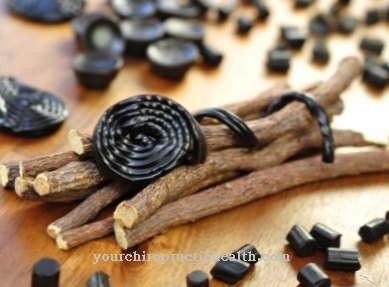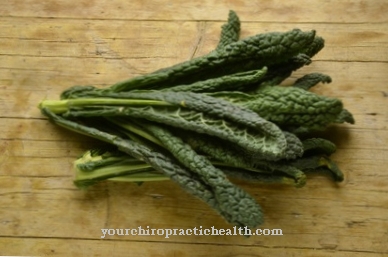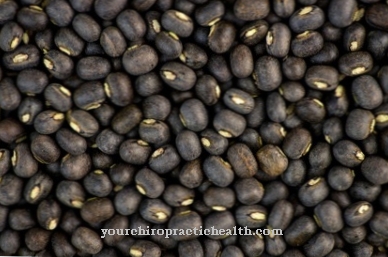The Nashi pear is an interesting alternative to conventional pears in terms of both taste and health. Originally from Asia, the Nashi pear has enriched not only the fruit basket in this country, but also various dishes for several years. Thanks to the numerous micronutrients it contains, their consumption has a positive effect on various areas of health.
What you should know about the nashi pear

The Nashi pear is an Asian fruit that has long since made its way into German supermarkets. It has been available sporadically in this country since the 1960s, and has finally established itself in the 1990s. Their origins are in northern China, Japan and Korea.
On the outside, the Nashi pear is reminiscent of a very light apple, on the inside it is more reminiscent of a crunchy pear. Therefore it is colloquially called Apple pear designated. Contrary to popular rumors, however, the Nashi pear is not a cross between the two types of fruit. In terms of taste, it represents a synthesis of apple, pear and melon, some varieties are also reminiscent of berries or roses. However, it actually belongs to the pear genus. The name Nashi pear (Pyrus pyrifolia) is, strictly speaking, a double, since "Nashi" already means "pear" in Japanese.
The Nashi pear grows on a tree that can be up to 15 meters high. The largest growing area for Nashi pears is in Japan. Around 1200 varieties of the fruit are known there. It is now also grown in Europe, especially in Italy and France, but also directly in Germany.
The best time to harvest the Nashi pear is in August and September. Shortly before picking it should have developed so-called "ripening cheeks". While they only reach a diameter of about 2.5 cm in their natural state, cultivated varieties are about the size of an average apple and weigh around 200 grams. The edible, yellowish to ocher-colored skin is thin and can - depending on the variety - be smooth or rough. The pulp of the Nashi pear is almost white, tastes sweet, sometimes also slightly sour and is pleasantly juicy with ripe fruits. With very ripe fruits, the consistency of the pulp can change to floury, but this does not affect the taste.
Importance to health
The Nashi pear is considered to be very healthy because it contains few calories - about as many as an apple or a pear - but contains many different vitamins and minerals.
The Nashi pear is said to have numerous health benefits. It is said to lower the cholesterol level, stimulate digestion and have a mild anti-inflammatory effect. Even if you have a hangover after drinking too much alcohol, it should provide relief. Since the pulp of the Nashi pear is very juicy, it also supplies the body with a relatively large amount of liquid. Since it also has a slightly dehydrating effect, it is also an interesting food for detox and purification cures as well as for people with kidney or bladder problems.
The abundant vitamin C it contains supports the immune system and ensures healthy blood vessels, the calcium strengthens the bones and the potassium regulates blood pressure. However, that doesn't end the list of their vitamins and minerals.
In order to benefit from all its valuable ingredients, the Nashi pear should be eaten raw as possible. Some of the nutrients can be lost during cooking.
Ingredients & nutritional values
100 grams of Nashi pear contain on average:
- 32kcal (134kJ)
- 0g protein
- 8g of carbohydrates
- of which 8g sugar
- 0g fat
- 2g of fiber
- 60% water
An average-sized Nashi pear weighs around 200 grams and therefore has around twice the nutritional value of the information given for 100 grams. The Nashi pear contains a lot of vitamin C (about 2mg per 100g), vitamin A, vitamins of the B group, calcium, iron, potassium, magnesium and phosphorus.
Intolerances & allergies
The Nashi pear can be an interesting food for fruit and cross allergy sufferers. Especially those who are allergic to apples do not always react with the typical allergy symptoms to the consumption of the Nashi pear and can still enjoy the taste of a fruit that is at least reminiscent of an apple. However, this should be tested carefully. Most people do not recommend consuming a Nashi pear.
Unfortunately, the Nashi pear has the reputation of being treated with an above-average amount of pesticides. Many people are also sensitive to pesticide residues, which should be considered when consuming.
Shopping & kitchen tips
The Nashi pear tastes best when it is really ripe. After its harvest, it spends up to six months in cold stores. Since it is also imported chilled, it can be stored for around two weeks after purchase - preferably at room temperature - and continue to mature during this time. At home, however, it should no longer be put in the refrigerator, as the frequent alternation of warm and cold can cause the aroma to suffer.
The Nashi pear is available in every well-stocked fruit and vegetable department in large supermarkets. Discounters, on the other hand, rarely have them in their range. In terms of price, the Nashi pear is usually a little above the level of domestic apples or pears.
Since the Nashi pear is very sensitive to pressure, it should be transported carefully. For this reason, when you buy it, it is often covered with a thicker mesh made of sturdy foam to protect the fruit. Usually the Nashi pear is sold individually. A single copy can easily be put in the shopping basket to try it out. For many people, the juicy, sweet pulp of the inconspicuous fruit is a pleasant surprise.
Preparation tips
The Nashi pear is usually enjoyed raw and in this case prepared like a conventional apple or pear. The core should be removed before consumption or left over like an apple. However, the Nashi pear is also surprisingly versatile: As an extraordinary ingredient, it is ideal for dessert creations - for example as a compote, in a fruit salad or in a cake - but also enriches hearty dishes such as colorful salads or game dishes.
There it is processed like a conventional pear and mostly steamed in the process. In combination with blue cheese, it tastes just as good as it does with nuts. The Nashi pear also tastes great with a good ham, for example as a starter or as finger food at a party.



























